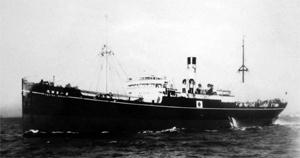RIKUGUN YUSOSEN
 (Sister YOSHIDA MARU No. 1, prewar)
(Sister YOSHIDA MARU No. 1, prewar)
IJA Transport ERIE MARU:
Tabular Record of
Movement
© 2013 Bob Hackett
29 October 1919:
Tsurumi. Laid down at Asano Shipbuilding Co. Ltd. as Yard
No. 21, a 5,493 -ton cargo ship for Ishihara Gomei-Kaisha, Fuchu.
7 April 1920:
Launched and named ERIE MARU
26 April 1920:
Completed.
1920-1934:
In Ishihara Gomei’ s service. Their principal business is
transporting iron ore from Batu Pahat and Johore, British Malaya to Yawata,
Japan.
21 March 1931:
Ishihara Gomei-Kaisha inaugurates shipping services on the Japan ~ Java, Netherland East Indies route.
28 November 1934:
Owner is restyled as Ishihara Sangyo Kaiun (ISK), Fuchu.
6 July 1935:
Under Government pressure, ISK, Nanyo Yusen and the
Japan-Netherland East Indies services of Osaka Shosen Kaisha (OSK) and Nippon Yusen Kaisha (NYK) are amalgamated to form a new company, the Nanyo Kaiun K. K. (South Seas Shipping). The previous owners all take a share of the new company.
12 September 1941:
Requisitioned by the Imperial Army as a troop transport/cargo ship. Assigned Army No. 584.
18 December 1941: The Invasion of the Philippines -“M” Operation (M Sakusen):
At 1700, ERIE MARU departs Mako, Pescadores for Lingayen Gulf, Philippines in Rear Admiral (later Vice Admiral) Rear Admiral Hara Kensaburo's (37)(former CO of TAKAO) 1st Lingayen Invasion Unit with 27 other IJA transports escorted by DesRon 5's light cruiser NATORI, DesDiv 5's ASAKAZE, HARUKAZE and MATSUKAZE, DesDiv 22's FUMIZUKI, MINAZUKI, NAGATSUKI and SATSUKI, minesweepers W-15 and W-16 and subchasers CH-1, CH-2, CH-3 CH-13, CH-14 and CH-15.
The Japanese main invasion at Lingayen Gulf consists of three transport echelons and carries the main part of LtGen Homma Masaharu's 80,000-man 14th Army. The first echelon is composed of 27 transports from Takao under Rear Admiral Hara , the second echelon of 28 transports under Rear Admiral (later Vice Admiral) Nishimura Shoji (39) and the third echelon of 21 transports from Keelung under Rear Admiral (later Vice Admiral) Hirose Sueto (39).
24 December 1941:
Lingayen Gulf. Between 0110 and 0430, the Lingayen Invasion Convoy lands troops at Lingayen.
9 August 1942:
ERIE MARU departs Mutsure in convoy No. 147 also
consisting of CLYDE, FUSHIMI and SHINAI MARUs and DAIGEN MARU No. 8 and three
unidentified ships escorted by destroyer KURETAKE and auxiliary gunboat PEKING
MARU.
13 August 1942:
Arrives at Mako.
28 October 1942:
ERIE MARU departs Manila for Davao, Mindanao via
Iloilo, Panay and Cebu City, Cebu Phillipines. She carries 1,000 Allied POWs,
mainly Americans and Filipinos.
7 November 1942:
Arrives at the port of Lasang, Mindanao.
1 May 1943:
ERIE MARU departs Takao escorting convoy No. 747 also
consisting of ZUISHO, RYOYO and KOZAN MARUs escorted by kaibokan SANAE.
5 May 1943:
Arrives at Manila.
8 February 1943:
At 1230, ERIE MARU departs Yokohama for Hokkaido
escorting convoy No. 1208A also consisting of HAKOZAKI and SHINTO (KAMISHIMA)
MARUs escorted by patrol boat PB-101.
20 July 1943:
At 1200, ERIE MARU departs Palau with escorting convoy
FU-006 consisting of INARI, KAMO, KENZAN, KINKASAN and NISSHU MARUs escorted by
patrol boat PB-46 and minesweeper W-17
E 21 July 1943:
At 10N, PB-46 and W-17 are detached to return to
Palau.
E 29 July 1943:
Minelayer NUWAJIMA and auxiliary minesweeper TAMA MARU
No. 7 join convoy FU-006 at 30N, 134E. At 1500, the convoy arrives at Fukajima.
21 September 1943:
ERIE MARU departs Saeki in convoy O-209 also
consisting of BRAZIL, FUKUYO, DAKAR, HOZUGAWA, KANAYAMASAN, KAYO and NITTAI
MARUs and SHINTO MARU No. 1 escorted by kaibokan IKI and auxiliary minesweepers
TAKUNAN MARU No. 3, AOI, YACHIYO, KOZAN MARUs and TOKUHO MARU No. 10.
E 22 September 1943:
Auxiliary minesweepers KOZAN MARU and TOKUHO
MARU No. 10 are detached at 30N.
E 23 September 1943:
Auxiliary minesweepers AOI and YACHIYO MARUs are
detached at 28N.
2 October 1943:
Arrives at Palau.
27 November 1943:
At 0700, ERIE MARU departs Shanghai in convoy
MO-707also consisting of DENMARK MARU and five unidentified ships escorted by
minelayer KAMOME.
E 1 December 1943:
Arrives at Moji.
5 December 1943:
At 0100, ERIE MARU departs Saeki in convoy O-506
consisting of DENMARK, ERIE, KOFUKU, SAIHO and SHINYO MARUs and TAIAN MARU No. 2
escorted by minelayer NUWAJIMA, minesweeper W-18 and auxiliary minesweepers TAMA
MARU No. 6 and OI MARU.
6 December 1943:
At 28N all escorts except W-18 are detached.
11 January 1944:
ERIE MARU departs Saeki for Rabaul in convoy O-105
consisting of DENMARK NARITA and YAMAZURU MARU escorted by minesweeper W-18 and
auxiliary minesweeper TAMA MARU. ERIE MARU is carrying about 2,500 Army troops
of the 5th Nanyo (South Seas) Group consisting of two large infantry groups, a
tank and an AA group
Bungo Straits. 20 miles east of Saeki, Kyushu. At about 1230, LtCdr
Charleton L. Murphy’s (USNA ’32) USS STURGEON (SS-187) torpedoes ERIE MARU in
hold No. 2 at 32-31N, 132-34E. At 1417, ERIE MARU heels over and sinks. About
200 troops are KIA. The escorts counter-attack and drop 51 depth-charges.
STURGEON incurs slight damage, but escapes. The remainder of the convoy returns
to port.
Author's Note:
Thanks go to Erich Muehlthaler of Germany.
Bob Hackett
Back to
IJA Transports





